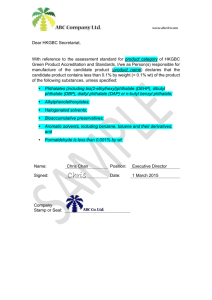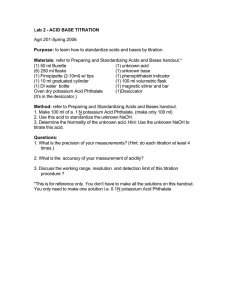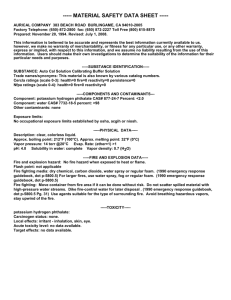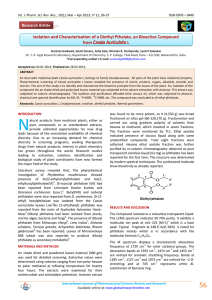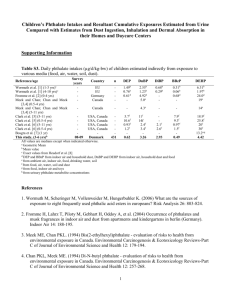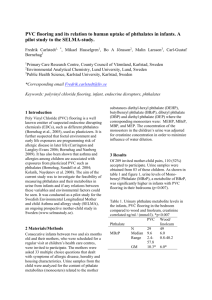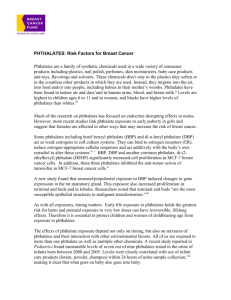METHOD 8061A PHTHALATE ESTERS BY GAS CHROMATOGRAPHY WITH ELECTRON CAPTURE DETECTION (GC/ECD) 1.0
advertisement
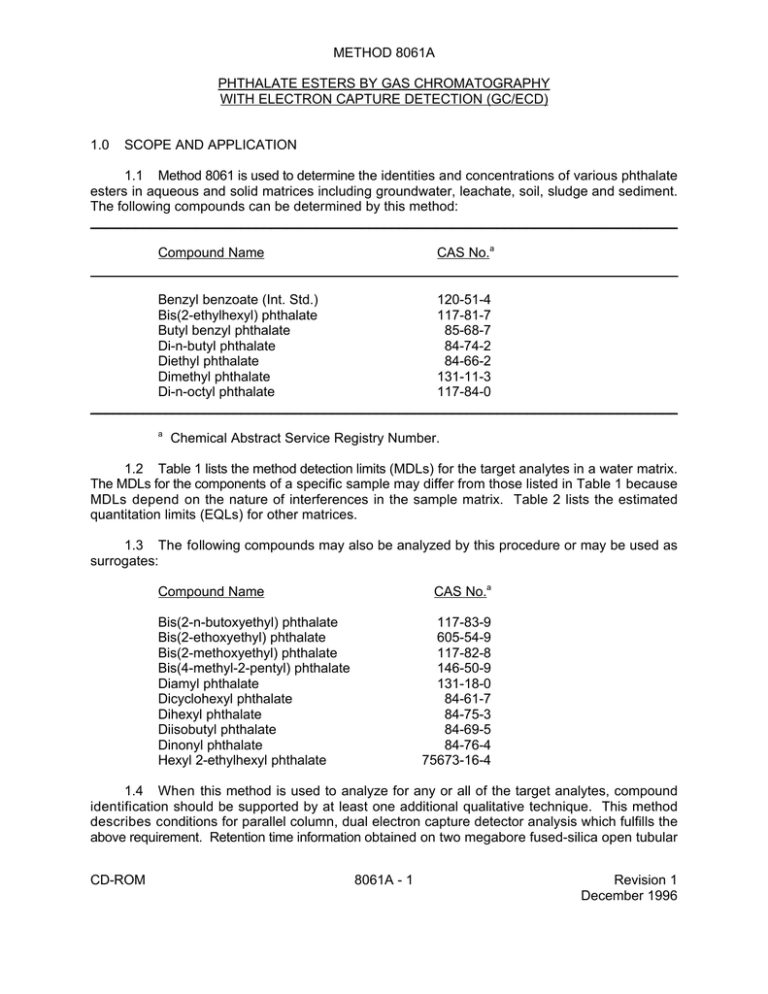
METHOD 8061A PHTHALATE ESTERS BY GAS CHROMATOGRAPHY WITH ELECTRON CAPTURE DETECTION (GC/ECD) 1.0 SCOPE AND APPLICATION 1.1 Method 8061 is used to determine the identities and concentrations of various phthalate esters in aqueous and solid matrices including groundwater, leachate, soil, sludge and sediment. The following compounds can be determined by this method: ______________________________________________________________________________ CAS No.a Compound Name Benzyl benzoate (Int. Std.) 120-51-4 Bis(2-ethylhexyl) phthalate 117-81-7 Butyl benzyl phthalate 85-68-7 Di-n-butyl phthalate 84-74-2 Diethyl phthalate 84-66-2 Dimethyl phthalate 131-11-3 Di-n-octyl phthalate 117-84-0 ______________________________________________________________________________ a Chemical Abstract Service Registry Number. 1.2 Table 1 lists the method detection limits (MDLs) for the target analytes in a water matrix. The MDLs for the components of a specific sample may differ from those listed in Table 1 because MDLs depend on the nature of interferences in the sample matrix. Table 2 lists the estimated quantitation limits (EQLs) for other matrices. 1.3 The following compounds may also be analyzed by this procedure or may be used as surrogates: CAS No.a Compound Name Bis(2-n-butoxyethyl) phthalate Bis(2-ethoxyethyl) phthalate Bis(2-methoxyethyl) phthalate Bis(4-methyl-2-pentyl) phthalate Diamyl phthalate Dicyclohexyl phthalate Dihexyl phthalate Diisobutyl phthalate Dinonyl phthalate Hexyl 2-ethylhexyl phthalate 117-83-9 605-54-9 117-82-8 146-50-9 131-18-0 84-61-7 84-75-3 84-69-5 84-76-4 75673-16-4 1.4 When this method is used to analyze for any or all of the target analytes, compound identification should be supported by at least one additional qualitative technique. This method describes conditions for parallel column, dual electron capture detector analysis which fulfills the above requirement. Retention time information obtained on two megabore fused-silica open tubular CD-ROM 8061A - 1 Revision 1 December 1996 columns is given in Table 1. Alternatively, gas chromatography/mass spectrometry could be used for compound confirmation. 1.5 Phthalate esters will hydrolyze below pH 5 and above pH 7. The amount of hydrolysis will increase with increasing or decreasing pH and with longer contact times. 1.6 This method is restricted for use by, or under the supervision of, analysts experienced in the use of gas chromatographs and skilled in the interpretation of gas chromatograms. Each analyst must demonstrate the ability to generate acceptable results with this method. 2.0 SUMMARY OF METHOD 2.1 A measured volume or weight of sample (approximately 1 liter for liquids, 10 to 30 grams for solids and sludges) is extracted using an appropriate 3500 series method. 2.1.1 Aqueous samples are extracted at a pH of 5 to 7, with methylene chloride, in a separatory funnel (Method 3510). Alternatively, particulate-free aqueous samples can be filtered through membrane disks that contain C18-bonded silica (Method 3535). The phthalate esters are retained by the bonded silica, eluted with acetonitrile, then exchanged to hexane. Using either method, aqueous samples should not be adjusted to basic pH, as phthalate esters will hydrolyze. Method 3520 is not recommended for the extraction of aqueous samples containing phthalates because the longer chain esters (dihexyl phthalate, bis(2-ethylhexyl) phthalate, di-n-octyl phthalate, and dinonyl phthalate) tend to adsorb to the glassware and consequently, their extraction recoveries are less than 40 percent. 2.1.2 Solid samples are extracted with methylene chloride/acetone (1:1) or hexane/acetone (1:1) using an appropriate 3500 series method. After cleanup, the extract is analyzed by gas chromatography with electron capture detection (GC/ECD). The methylene chloride/acetone solvent system has generally been found to be more effective at extracting the analytes of interest from solid matrices. The hexane/acetone solvent system may be appropriate in instances where specific interferences are expected. 2.2 The sensitivity of Method 8061 usually depends on the level of interferences rather than on instrumental limitations. If interferences prevent detection of the analytes, cleanup of the sample extracts is necessary. Either Method 3610 or 3620 alone or followed by Method 3660, Sulfur Cleanup, may be used to eliminate interferences in the analysis. Method 3640, Gel Permeation Cleanup, is applicable for samples that contain high amounts of lipids and waxes. 3.0 INTERFERENCES 3.1 Refer to Methods 3500, 3600, and 8000. 3.2 Interferences coextracted from the samples will vary considerably from waste to waste. While general cleanup techniques are referenced or provided as part of this method, unique samples may require additional cleanup approaches to achieve desired sensitivities for the target analytes. 3.3 Glassware must be scrupulously clean. All glassware requires treatment in a muffle furnace at 400EC for 2 to 4 hrs, or thorough rinsing with pesticide-grade solvent, prior to use. Refer CD-ROM 8061A - 2 Revision 1 December 1996 to Chapter Four, Sec. 4.1.4, for further details regarding the cleaning of glassware. Volumetric glassware should not be heated in a muffle furnace. NOTE: If Soxhlet extractors are baked in the muffle furnace, care must be taken to ensure that they are dry (breakage may result if any water is left in the side-arm). Thorough rinsing with hot tap water, followed by deionized water and acetone, is not an adequate decontamination procedure. Even after a Soxhlet extractor was refluxed with acetone for three days, with daily solvent changes, the concentration of bis(2-ethylhexyl) phthalate was as high as 500 ng per washing. Storage of glassware in the laboratory introduces contamination, even if the glassware is wrapped in aluminum foil. Therefore, any glassware used in Method 8061 should be cleaned immediately prior to use. 3.4 Florisil and alumina may be contaminated with phthalate esters and, therefore, use of these materials in sample cleanup should be employed cautiously. If these materials are used, they must be obtained packaged in glass (plastic packaging will contribute to contamination with phthalate esters). Washing of these materials prior to use with the solvent(s) used for elution during extract cleanup was found helpful, however, heating at 320EC for Florisil and 210EC for alumina is recommended. Phthalate esters were detected in Florisil cartridge method blanks at concentrations ranging from 10 to 460 ng, with 5 phthalate esters in the 105 to 460 ng range. Complete removal of the phthalate esters from Florisil cartridges does not seem possible, and it is therefore desirable to keep the steps involved in sample preparation to a minimum. 3.5 Paper thimbles and filter paper must be exhaustively washed with the solvent that will be used in the sample extraction. Soxhlet extraction of paper thimbles and filter paper for 12 hrs with fresh solvent should be repeated a minimum of three times. Method blanks should be obtained before any of the precleaned thimbles or filter papers are used. Storage of precleaned thimbles and filter paper in precleaned glass jars covered with aluminum foil is recommended. 3.6 Glass wool used in any step of sample preparation should be a specially treated Pyrex® wool, pesticide grade, and must be baked at 400EC for 4 hrs. immediately prior to use. 3.7 Sodium sulfate must be obtained packaged in glass (plastic packaging will contribute to contamination with phthalate esters), and must be purified by heating at 400EC for 4 hrs. in a shallow tray, or by precleaning with methylene chloride. To avoid recontamination, the precleaned material must be stored in glass-stoppered glass bottles, or glass bottles covered with precleaned aluminum foil. The storage period should not exceed two weeks. To minimize contamination, extracts should be dried directly in the glassware in which they are collected by adding small amounts of precleaned sodium sulfate until an excess of free-flowing material is noted. 3.8 The presence of elemental sulfur will result in large peaks which often mask the region of the compounds eluting before dicyclohexyl phthalate (Compound No. 14) in the gas chromatograms shown in Figure 1. Method 3660 is suggested for removal of sulfur. 3.9 Waxes and lipids can be removed by Gel Permeation Chromatography (Method 3640). Extracts containing high concentrations of lipids are viscous, and may even solidify at room temperature. Phthalates elute just after corn oil in the GPC program. CD-ROM 8061A - 3 Revision 1 December 1996 4.0 APPARATUS AND MATERIALS 4.1 Gas chromatography. 4.1.1 Gas chromatograph - analytical system complete with gas chromatograph suitable for on-column and split/splitless injections and all required accessories, including detector, analytical columns, recorder, gases, and syringes. A data system for measuring peak heights and/or peak areas is recommended. 4.1.1.1 Eight inch injection tee (Supelco, Inc., Catalog No. 2-3665, or equivalent) or glass Y splitter for megabore columns (J&W Scientific, "press-fit", Catalog No. 705-0733, or equivalent). 4.1.2 Columns. 4.1.2.1 Column 1 - 30 m x 0.53 mm ID, 5% phenyl/95% methyl silicone fusedsilica open tubular column (DB-5, J&W Scientific, or equivalent), 1.5 µm film thickness. 4.1.2.2 Column 2 - 30 m x 0.53 mm ID, 14% cyanopropyl phenyl silicone fused-silica open tubular column (DB-1701, J&W Scientific, or equivalent), 1.0 µm film thickness. 4.1.3 4.2 5.0 Detector - Dual electron capture detector (ECD). Glassware - see appropriate 3500 series method for specifications. REAGENTS 5.1 Reagent grade chemicals shall be used in all tests. Unless otherwise indicated, it is intended that all reagents shall conform to the specifications of the Committee on Analytical Reagents of the American Chemical Society, where such specifications are available. Other grades may be used, provided it is first ascertained that the reagent is of sufficiently high purity to permit its use without lessening the accuracy of the determination. 5.2 Phthalates are ubiquitous laboratory contaminants. Each lot of reagents used for this method should be checked for phthalate contamination. Additional demonstration that reagents are free of contamination may be required because reagents may become contaminated during storage in the laboratory environment. 5.3 Hexane, C6H14 - Pesticide quality, or equivalent. 5.4 Stock standard solutions: 5.4.1 Prepare stock standard solutions at a concentration of 1000 mg/L by dissolving 0.0100 g of assayed reference material in hexane and diluting to volume in a 10 mL volumetric flask. When compound purity is assayed to be 96 percent or greater, the weight can be used without correction to calculate the concentration of the stock standard. Commercially prepared stock standard solutions can be used at any concentration if they are certified by the manufacturer or by an independent source. CD-ROM 8061A - 4 Revision 1 December 1996 5.4.2 Transfer the stock standard solutions into glass vials with polytetrafluoroethylene (PTFE)-lined screw-caps or crimp tops. Store at 4EC and protect from light. Stock standard solutions should be checked periodically by gas chromatography for signs of degradation or evaporation, especially just prior to preparation of calibration standards. 5.4.3 Stock standard solutions must be replaced after 6 months, or sooner if comparison with check standards indicates a problem. 5.5 Calibration standards: Calibration standards are prepared at a minimum of five concentrations for each parameter of interest through dilution of the stock standard solutions with hexane. One of the concentrations should be at a concentration near, but above, the method detection limit. The remaining concentrations should correspond to the expected range of concentrations found in real samples, or should define the working range of the GC. Calibration solutions must be replaced after 1 to 2 months, or sooner if comparison with calibration verification standards indicates a problem. 5.6 Internal standards (if internal standard calibration is used): To use this approach, the analyst must select one or more internal standards that are similar in analytical behavior to the compounds of interest. The analyst must further demonstrate that the measurement of the internal standard is not affected by method or matrix interferences. Benzyl benzoate has been tested and found appropriate for Method 8061. 5.6.1 Prepare a spiking solution of benzyl benzoate in hexane at 5000 mg/L. Addition of 10 µL of this solution to 1 mL of sample extract is recommended. The spiking concentration of the internal standard should be kept constant for all samples and calibration standards. Store the internal standard spiking solution at 4EC in glass vials with PTFE-lined screw-caps or crimp tops. Standard solutions should be replaced when ongoing QC (Sec. 8.0) indicates a problem. 5.7 Surrogate standards: The analyst should monitor the performance of the extraction, cleanup (when used), analytical system, and the effectiveness of the method in dealing with each sample matrix by spiking each sample, standard, and blank with surrogate compounds. Three surrogates are suggested for Method 8061: diphenyl phthalate, diphenyl isophthalate, and dibenzyl phthalate. 5.7.1 Prepare a surrogate standard spiking solution in acetone which contains 50 ng/µL of each compound. Addition of 500 µL of this solution to 1 L of water or 30 g solid sample is equivalent to 25 µg/L of water or 830 µg/kg of solid sample. The spiking concentration of the surrogate standards may be adjusted accordingly if the final volume of extract is reduced below 2 mL for water samples or 10 mL for solid samples. Store the surrogate spiking solution at 4EC in glass vials with PTFE-lined screw-caps or crimp tops. The solution must be replaced after 6 months, or sooner if ongoing QC (Sec. 8.0) indicates problems. 5.8 Matrix spike solution: Analysts should select phthalates of the greatest interest as the matrix spike compounds. If no other guidance is provided to the analyst, selected water samples should be spiked with 20-60 µg/L of butylbenzyl phthalate and diethylhexyl phthalate and selected solid samples should be spiked with 1-3 mg/kg of butylbenzyl phthalate and diethylhexyl phthalate. The matrix spiking solution should be prepared in acetone. CD-ROM 8061A - 5 Revision 1 December 1996 6.0 SAMPLE COLLECTION, PRESERVATION, AND HANDLING 6.1 7.0 See the introductory material to this chapter, Organic Analytes, Sec. 4.1. PROCEDURE 7.1 Extraction: Refer to Chapter Two and Method 3500 for guidance on choosing the appropriate extraction procedure. 7.1.1 In general, water samples should be extracted at a pH of 5 to 7 with methylene chloride using an appropriate 3500 series method for aqueous matrices (such as Methods 3510 or 3535). Using either method, aqueous samples should not be adjusted to basic pH, as phthalate esters will hydrolyze. Method 3520 is not recommended for the extraction of aqueous samples because the longer chain esters (dihexyl phthalate, bis(2-ethylhexyl) phthalate, di-n-octyl phthalate, and dinonyl phthalate) tend to adsorb to the glassware and consequently, their extraction recoveries are less than 40 percent. 7.1.2 Solid samples should be extracted with methylene chloride/acetone (1:1) or hexane/acetone (1:1) using an appropriate 3500 series method for solid matrices. The methylene chloride/acetone solvent system has generally been found to be more effective at extracting the analytes of interest from solid matrices. The hexane/acetone solvent system may be appropriate in instances where specific interferences are expected. 7.1.3 Immediately prior to extraction, spike 500 µL of the surrogate standard spiking solution (concentration = 50 ng/µL) into 1 L of aqueous sample or 30 g solid sample. 7.2 Cleanup: Refer to Method 3600 for guidance on choosing an appropriate cleanup procedure. Cleanup may not be necessary for extracts from a relatively clean sample matrix. 7.2.1 Methods 3610 and 3620 describe procedures for sample cleanup using alumina and Florisil Cartridges. With these methods, bis(2-methoxyethyl) phthalate, bis(2-ethoxyethyl) phthalate, and bis(2-n-butoxyethyl) phthalate are recovered quantitatively. NOTE: It is important to demonstrate through the analyses of standards that the Florisil fractionation scheme is reproducible. When using the fractionation schemes given in Methods 3610 or 3620, batch-to-batch variations in the composition of the alumina or Florisil material may cause variations in the recoveries of the phthalate esters. 7.2.2 Waxes and lipids can be removed by Gel Permeation Chromatography (Method 3640). Phthalates elute just after corn oil in the GPC program. 7.3 Gas chromatographic conditions (recommended): 7.3.1 Column 1 and Column 2 (Sec. 4.1.2): Carrier gas (He) Makeup gas (N2) Injector temperature Detector temperature CD-ROM = = = = 6 mL/min. 19 mL/min. 250EC. 320EC. 8061A - 6 Revision 1 December 1996 Injection volume = Column temperature: Initial temperature = Temperature program = Final temperature = 2 µm 150EC, hold for 0.5 min. 150EC to 220EC at 5EC/min., followed by 220EC to 275EC at 3EC/min. 275EC hold for 13 min. 7.3.2 Table 1 gives the retention times and MDLs that can be achieved by this method for the 16 phthalate esters. An example of the separation achieved with the DB-5 and DB1701 fused-silica open tubular columns is shown in Figure 1. 7.4 Calibration: 7.4.1 Refer to Method 8000 for proper calibration techniques. Use Tables 1 and 2 for guidance on selecting the lowest point on the calibration curve. 7.4.2 The procedure for internal or external calibration may be used. Refer to Method 8000 for the description of each of these procedures. 7.5 Gas chromatographic analysis: 7.5.1 Refer to Method 8000. If the internal standard calibration technique is used, add 10 µL of internal standard solution to the sample at 5000 mg/L prior to injection. 7.5.2 Follow Method 8000 for instructions on the analysis sequence, appropriate dilutions, establishing daily retention time windows, and identification criteria. 7.5.3 Record the sample volume injected and the resulting peak areas. 7.5.4 Using either the internal or the external calibration procedure (Method 8000), determine the identity and the quantity of each component peak in the sample chromatogram which corresponds to the compounds used for calibration purposes. 7.5.5 At a minimum, a mid-concentration calibration standard should be included after each group of 20 samples in the analysis sequence. 7.5.6 If the response of a peak exceeds the working range of the system, dilute the extract and reanalyze. 7.5.7 Refer to Method 8000 for guidance on establishing retention time windows and identifying target analytes. 7.6.8 GC/MS confirmation: Any compounds confirmed by two columns may also be confirmed by GC/MS if the concentration is sufficient for detection by GC/MS as determined by the laboratory-generated detection limits. 7.6.8.1 The GC/MS would normally require a minimum concentration of 10 ng/µL in the final extract for each single-component compound. 7.6.8.2 The sample extract and associated blank should be analyzed by GC/MS as per Sec. 7.0 of Method 8270. Normally, analysis of a blank is not required for CD-ROM 8061A - 7 Revision 1 December 1996 confirmation analysis, however, analysis for phthalates is a special case because of the possibility for sample contamination through septum punctures, etc. 7.6.8.3 A reference standard of the compound must also be analyzed by GC/MS. The concentration of the reference standard must be at a concentration that would demonstrate the ability to confirm the phthalate esters identified by GC/ECD. 8.0 QUALITY CONTROL 8.1 Refer to Chapter One and Method 8000 for specific quality control (QC) procedures. Quality control procedures to ensure the proper operation of the various sample preparation and/or sample introduction techniques can be found in Methods 3500 and 5000. Each laboratory should maintain a formal quality assurance program. The laboratory should also maintain records to document the quality of the data generated. 8.2 Quality control procedures necessary to evaluate the GC system operation are found in Method 8000, Sec. 7.0 and includes evaluation of retention time windows, calibration verification and chromatographic analysis of samples. 8.3 Initial Demonstration of Proficiency - Each laboratory must demonstrate initial proficiency with each sample preparation and determinative method combination it utilizes, by generating data of acceptable accuracy and precision for target analytes in a clean matrix. The laboratory must also repeat the following operations whenever new staff are trained or significant changes in instrumentation are made. See Method 8000, Sec. 8.0 for information on how to accomplish this demonstration. 8.4 Sample Quality Control for Preparation and Analysis - The laboratory must also have procedures for documenting the effect of the matrix on method performance (precision, accuracy, and detection limit). At a minimum, this includes the analysis of QC samples including a method blank, a matrix spike, a duplicate, and a laboratory control sample (LCS) in each analytical batch and the addition of surrogates to each field sample and QC sample. 8.4.1 Documenting the effect of the matrix should include the analysis of at least one matrix spike and one duplicate unspiked sample or one matrix spike/matrix spike duplicate pair. The decision on whether to prepare and analyze duplicate samples or a matrix spike/matrix spike duplicate must be based on a knowledge of the samples in the sample batch. If samples are expected to contain target analytes, then laboratories may use one matrix spike and a duplicate analysis of an unspiked field sample. If samples are not expected to contain target analytes, laboratories should use a matrix spike and matrix spike duplicate pair. 8.4.2 A Laboratory Control Sample (LCS) should be included with each analytical batch. The LCS consists of an aliquot of a clean (control) matrix similar to the sample matrix and of the same weight or volume. The LCS is spiked with the same analytes at the same concentrations as the matrix spike. When the results of the matrix spike analysis indicate a potential problem due to the sample matrix itself, the LCS results are used to verify that the laboratory can perform the analysis in a clean matrix. 8.4.3 See Method 8000, Sec. 8.0 for the details on carrying out sample quality control procedures for preparation and analysis. CD-ROM 8061A - 8 Revision 1 December 1996 8.5 Surrogate recoveries - The laboratory must evaluate surrogate recovery data from individual samples versus the surrogate control limits developed by the laboratory. See Method 8000, Sec. 8.0 for information on evaluating surrogate data and developing and updating surrogate limits. 8.6 It is recommended that the laboratory adopt additional quality assurance practices for use with this method. The specific practices that are most productive depend upon the needs of the laboratory and the nature of the samples. Whenever possible, the laboratory should analyze standard reference materials and participate in relevant performance evaluation studies. 9.0 METHOD PERFORMANCE 9.1 The MDL is defined in Chapter One. The MDL concentrations listed in Table 1 were obtained using organic-free reagent water. Details on how to determine MDLs are given in Chapter One. The MDL actually achieved in a given analysis will vary, as it is dependent on instrument sensitivity and matrix effects. 9.2 This method has been tested in a single laboratory by using different types of aqueous samples and solid samples which were fortified with the test compounds at two concentrations. Single-operator precision, overall precision, and method accuracy were found to be related to the concentration of the compounds and the type of matrix. Results of single-laboratory method evaluation using extraction Methods 3510 and 3550 are presented in Tables 5 and 6. 9.3 Accuracy and precision data for extraction using C18-extraction disk Method 3535 are presented in Table 4. 9.4 The accuracy and precision obtained is determined by the sample matrix, sample preparation technique, cleanup techniques, and calibration procedures used. 10.0 REFERENCES 1. Glazer, J.A., Foerst, G.D., McKee, G.D., Quave, S.A., and Budde, W.L., "Trace Analyses for Wastewaters", Environ. Sci. and Technol. 15: 1426, 1981. 2. Lopez-Avila, V., Baldin, E., Benedicto, J., Milanes, J., and Beckert, W.F., "Application of OpenTubular Columns to SW-846 GC Methods", U.S. Environmental Protection Agency, EMSL-Las Vegas, NV, 1990. 3. Beckert, W.F. and Lopez-Avila, V., "Evaluation of SW-846 Method 8060 for Phthalate Esters", Proceedings of Fifth Annual Waste Testing and Quality Assurance Symposium, U.S. Environmental Protection Agency, 1989. CD-ROM 8061A - 9 Revision 1 December 1996 TABLE 1 GAS CHROMATOGRAPHIC RETENTION TIMES AND METHOD DETECTION LIMITS FOR THE PHTHALATE ESTERSa Compound No. 1 2 3 4 5 6 7 8 9 10 11 12 13 14 15 16 IS SU-1 SU-2 SU-3 a Compound Name Dimethyl phthalate (DMP) Diethyl phthalate (DEP) Diisobutyl phthalate (DIBP) Di-n-butyl phthalate (DBP) Bis(4-methyl-2-pentyl) phthalate (BMPP) Bis(2-methoxyethyl) phthalate (BMEP) Diamyl phthalate (DAP) Bis(2-ethoxyethyl) phthalate (BEEP) Hexyl 2-ethylhexyl phthalate (HEHP) Dihexyl phthalate (DHP) Butyl benzyl phthalate (BBP) Bis(2-n-butoxyethyl) phthalate (BBEP) Bis(2-ethylhexyl) phthalate (DEHP) Dicyclohexyl phthalate (DCP) Di-n-octyl phthalate (DOP) Dinonyl phthalate Benzyl benzoate Diphenyl phthalate (DPP) Diphenyl isophthalate (DPIP) Dibenzyl phthalate (DBZP) Chemical Abstract Registry No. 131-11-3 84-66-2 84-69-5 84-74-2 146-50-9 117-82-8 131-18-0 605-54-9 75673-16-4 84-75-3 85-68-7 117-83-9 117-81-7 84-61-7 117-84-0 84-76-4 120-51-4 84-62-8 744-45-6 523-31-9 Retention Time (min) Column 1 7.06 9.30 14.44 16.26 18.77 17.02 20.25 19.43 21.07 24.57 24.86 27.56 29.23 28.88 33.33 38.80 12.71 29.46 32.99 34.40 Column 2 6.37 8.45 12.91 14.66 16.27 16.41 18.08 18.21 18.97 21.85 23.08 25.24 25.67 26.35 29.83 33.84 11.07 28.32 31.37 32.65 MDLb Liquid (ng/L) 640 250 120 330 370 510 110 270 130 68 42 84 270 22 49 22 c c c c Column 1 is a 30 m x 0.53 mm ID DB-5 fused-silica open tubular column (1.5 µm film thickness). Column 2 is a 30 m 0.53 mm ID DB-1701 fused-silica open tubular column (1.0 µm film thickness). Temperature program is 150EC (0.5 min hold) to 220EC at 5EC/min, then to 275EC (13 min hold) at 3EC/min. An 8-in Supelco injection tee or a J&W Scientific press fit glass inlet CD-ROM 8061A - 10 Revision 1 December 1996 Table 1. (continued) splitter is used to connect the two columns to the injection port of a gas chromatograph. Carrier gas helium at 6 mL/min; makeup gas nitrogen at 20 mL/min; injector temperature 250EC; detector temperature 320EC. b MDL is the method detection limit. The MDL was determined from the analysis of seven replicate aliquots of organicfree reagent water processed through the entire analytical method (extraction, Florisil cartridge cleanup, and GC/ECD analysis using the single column approach: DB-5 fused-silica capillary column). MDL = t(n-1, 0.99) x SD where t(n-1, 0.99) is the student's t value appropriate for a 99 percent confidence interval and a standard deviation with n-1 degrees of freedom, and SD is the standard deviation of the seven replicate measurements. Values measured were not corrected for method blanks. c Not applicable. CD-ROM 8061A - 11 Revision 1 December 1996 TABLE 2 ESTIMATED QUANTITATION LIMITS (EQL) FOR VARIOUS MATRICESa ______________________________________________________________________________ Matrix Factorb ______________________________________________________________________________ Groundwater 10 Low-concentration soil by ultrasonic extraction 670 with GPC cleanup High-concentration soil and sludges by ultrasonic 10,000 extraction Non-water miscible waste 100,000 ______________________________________________________________________________ a Sample EQLs are highly matrix dependent. The EQLs listed herein are provided for guidance and may not always be achievable. b EQL = [Method detection limit (Table 1)] X [Factor (Table 2)]. For nonaqueous samples, the factor is on a wet weight basis. CD-ROM 8061A - 12 Revision 1 December 1996 TABLE 3 AVERAGE RECOVERIES OF METHOD 8061 COMPOUNDS USING METHODS 3610 AND 3620 ______________________________________________________________________________ Compound Alumina columna Florisil columna Alumina cartridgeb Florisil cartridged ______________________________________________________________________________ Dimethyl phthalate 64.5 40.0 101 89.4 Diethyl phthalate 62.5 57.0 103 97.3 Diisobutyl phthalate 77.0 80.0 104 91.8 Di-n-butyl phthalate 76.5 85.0 108 102 Bis(4-methyl-2-pentyl) phthalate 89.5 84.5 103 105 Bis(2-methoxyethyl) phthalate 70.5 0 64.1c 78.3e Diamyl phthalate 75.0 81.5 103 94.5 Bis(2-ethoxyethyl) phthalate 67.0 0 111 93.6 Hexyl 2-ethylhexyl phthalate 90.5 105 101 96.0 Dihexyl phthalate 73.0 74.5 108 96.8 Benzyl butyl phthalate 87.0 90.0 103 98.6 Bis(2-n-butoxyethyl) phthalate 62.5 0 108 91.5 Bis(2-ethylhexyl) phthalate 91.0 82.0 97.6 97.5 Dicyclohexyl phthalate 84.5 83.5 97.5 90.5 Di-n-octyl phthalate 108 115 112 97.1 Dinonyl phthalate 71.0 72.5 97.3 105 ______________________________________________________________________________ a 2 determinations; alumina and Florisil chromatography performed according to Methods 3610 and 3620, respectively. b 2 determinations, using 1 g alumina cartridges; Fraction 1 was eluted with 5 mL of 20-percent acetone in hexane; 40 µg of each component was spiked per cartridge. c 36.8 percent was recovered by elution with an additional 5 mL of 20-percent acetone in hexane. d 2 determinations, using 1 g Florisil cartridges; Fraction 1 was eluted with 5 mL of 10-percent acetone in hexane. 40 µg of each component was spiked per cartridge. e 14.4 percent was recovered by elution with an additional 5 mL of 10-percent acetone in hexane. CD-ROM 8061A - 13 Revision 1 December 1996 TABLE 4 ACCURACY AND PRECISION DATA FOR EXTRACTION USING METHOD 3535 AND METHOD 8061 ______________________________________________________________________________ HPLC-grade water Groundwater Average Average recovery Precision recovery Precision Compound (%) (% RSD) (%) (% RSD) _____________________________________________________________________________ Dimethyl phthalate 88.6 17.7 86.6 14.3 Diethyl phthalate 92.3 10.3 92.6 7.2 Diisobutyl phthalate 87.6 16.2 89.3 1.6 Di-n-butyl phthalate 90.3 13.2 95.0 1.5 Bis(4-methyl-2-pentyl) phthalate 87.2 9.5 86.7 4.9 Bis(2-methoxyethyl) phthalate 107 13.6 113 2.8 Diamyl phthalate 93.6 21.0 78.9 5.8 Bis(2-ethoxyethyl) phthalate 108 8.9 102 4.0 Hexyl 2-ethylhexyl phthalate 93.9 22.4 83.4 8.8 Dihexyl phthalate 98.4 5.0 97.7 14.8 Benzyl butyl phthalate 97.3 2.6 66.0 39.3 Bis(2-n-butoxyethyl) phthalate 94.8 6.3 98.7 6.0 Bis(2-ethylhexyl) phthalate 91.3 7.4 96.3 7.9 Dicyclohexyl phthalate 106 19.9 108 13.3 Di-n-octyl phthalate 84.9 3.8 90.1 6.1 Dinonyl phthalate 96.9 11.1 95.2 12.7 ______________________________________________________________________________ a The number of determinations was 4. The spiking concentration was 100 µg/L per component. CD-ROM 8061A - 14 Revision 1 December 1996 TABLE 5 ACCURACY AND PRECISION DATA FOR METHOD 3510 AND METHOD 8061a ________________________________________________________________________________________________________________________ Spike Concentration Spike Concentration (20 µg/L) (60 µg/L) Estuarine Estuarine Compound Water Leachate Groundwater Water Leachate Groundwater ________________________________________________________________________________________________________________________ Dimethyl phthalate 84.0 (4.1) 98.9 (19.6) 87.1 (8.1) 87.1 (7.5) 112 (17.5) 90.9 (4.5) Diethyl phthalate 71.2 (3.8) 82.8 (19.3) 88.5 (15.3) 71.0 (7.7) 88.5 (17.9) 75.3 (3.5) Diisobutyl phthalate 76.0 (6.5) 95.3 (16.9) 92.7 (17.1) 99.1 (19.0) 100 (9.6) 83.2 (3.3) Di-n-butyl phthalate 83.2 (6.5) 97.5 (22.3) 91.0 (10.7) 87.0 (8.0) 106 (17.4) 87.7 (2.7) Bis(4-methyl-2-pentyl) phthalate 78.6 (2.6) 87.3 (18.2) 92.6 (13.7) 97.4 (15.0) 107 (13.3) 87.6 (2.9) Bis(2-methoxyethyl) phthalate 73.8 (1.0) 87.2 (21.7) 82.4 (4.4) 82.5 (5.5) 99.0 (13.7) 76.9 (6.6) Diamyl phthalate 78.2 (7.3) 92.1 (21.5) 88.8 (7.5) 89.2 (2.8) 112 (14.2) 92.5 (1.8) Bis(2-ethoxyethyl) phthalate 75.6 (3.3) 90.8 (22.4) 86.4 (5.8) 88.7 (4.9) 109 (14.6) 84.8 (5.9) Hexyl 2-ethylhexyl phthalate 84.7 (5.3) 91.1 (27.5) 81.4 (17.6) 107 (16.8) 117 (11.4) 80.1 (4.1) Dihexyl phthalate 79.8 (7.2) 102 (21.5) 90.9 (7.6) 90.1 (2.4) 109 (20.7) 88.9 (2.4) Benzyl butyl phthalate 84.1 (6.4) 105 (20.5) 89.6 (6.1) 92.7 (5.6) 117 (24.7) 93.0 (2.O) Bis(2-n-butoxyethyl) phthalate 78.5 (3.5) 92.3 (16.1) 89.3 (3.6) 86.1 (6.2) 107 (15.3) 92.4 (0.6) Bis(2-ethylhexyl) phthalate 81.4 (4.1) 93.0 (15.0) 90.5 (4.9) 86.5 (6.9) 108 (15.1) 91.1 (3.0) Dicyclohexyl phthalate 77.4 (6.5) 88.2 (13.2) 91.7 (15.2) 87.7 (9.6) 102 (14.3) 71.9 (2.4) Di-n-octyl phthalate 74.9 (4.9) 87.5 (18.7) 87.2 (3.7) 85.1 (8.3) 105 (17.7) 90.4 (2.0) Dinonyl phthalate 59.5 (6.1) 77.3 (4.2) 67.2 (8.0) 97.2 (7.0) 108 (17.9) 90.1 (1.1) Surrogates: Diphenyl phthalate 98.5 (2.6) 113 (14.9) 110 (3.3) 110 (12.4) 95.1 (7.2) 107 (2.4) Diphenyl isophthalate 95.8 (1.9) 112 (11.7) 109 (3.3) 104 (5.9) 97.1 (7.1) 106 (2.8) Dibenzyl phthalate 93.9 (4.4) 112 (14.0) 106 (3.8) 111 (5.9) 93.3 (9.5) 105 (2.4) ________________________________________________________________________________________________________________________ a The number of determinations was 3. The values given in parentheses are the percent relative standard deviations of the average recoveries. CD-ROM 8061A - 15 Revision 1 December 1996 TABLE 6 ACCURACY AND PRECISION DATA FOR METHOD 3550 AND METHOD 8061a _____________________________________________________________________________________________________________________________ Spike Concentration (1 mg/kg) Spike Concentration (3 µg/g) Municipal Sandy Loam Estuarine Municipal Sandy Loam Estuarine Compound Sediment Sludge Soil Sediment Sludge Soil _____________________________________________________________________________________________________________________________ c Dimethyl phthalate 77.9 (42.8) 52.1 (35.5) 136 (9.6) 64.8 (11.5) 70.2 (2.0) Diethyl phthalate 68.4 (1.7) 68.6 (9.1) 54.7 (6.2) 60.2 (12.5) 72.8 (10.0) 67.0 (15.1) Diisobutyl phthalate 103 (3.1) 106 (5.3) 70.3 (3.7) 74.8 (6.0) 84.0 (4.6) 79.2 (0.1) Di-n-butyl phthalate 121 (25.8) 86.3 (17.7) 72.6 (3.7) 74.6 (3.9) 113 (5.8) 70.9 (5.5) Bis(4-methyl-2-pentyl) phthalate 108 (57.4) 97.3 (7.4) 104 (1.5) 150 (6.1) 83.9 (11.8) c Bis(2-methoxyethyl) phthalate 26.6 (26.8) 72.7 (8.3) 0 19.5 (14.8) 59.9 (5.4) 0 Diamyl phthalate 95.0 (10.2) 81.9 (7.1) 81.9 (15.9) 77.3 (4.0) 116 (3.7) 82.1 (15.5) c c Bis(2-ethoxyethyl) phthalate 66.6 (4.9) 21.7 (22.8) 57.5 (9.2) 84.7 (8.5) c Hexyl 2-ethylhexyl phthalate 114 (10.5) 57.7 (2.8) 72.7 (11.3) 26.6 (47.6) 28.4 (4.3) Dihexyl phthalate 103 (3.6) 96.4 (10.7) 77.9 (2.4) 75.5 (6.8) 80.3 (4.7) 79.5 (2.7) Benzyl butyl phthalate 113 (12.8) 82.8 (7.8) 56.5 (5.1) 72.9 (3.4) 76.8 (10.3) 67.3 (3.8) c Bis(2-n-butoxyethyl) phthalate 114 (21.1) 74.0 (15.6) 38.3 (25.1) 98.0 (6.4) 62.0 (3.4) c Bis(2-ethylhexyl) phthalate 76.6 (10.6) 99.2 (25.3) 59.5 (18.3) 85.8 (6.4) 65.4 (2.8) Dicyclohexyl phthalate 36.6 (48.8) 65.8 (15.7) 92.8 (35.9) 33.9 (66.1) 68.5 (9.6) 62.2 (19.1) c Di-n-octyl phthalate 93.3 (14.6) 84.7 (9.3) 36.8 (16.4) 88.4 (7.4) 115 (29.2) c c Dinonyl phthalate 80.0 (41.1) 64.2 (17.2) 156 (8.6) 115 (13.2) _____________________________________________________________________________________________________________________________ a The number of determinations was 3. The values given in parentheses are the percent relative standard deviations of the average recoveries. All samples were subjected to Florisil cartridge cleanup. b The estuarine sediment extract (Florisil, Fraction 1) was subjected to sulfur cleanup (Method 3660 with tetrabutylammonium sulfite reagent). c Not able to determine because of matrix interferant. CD-ROM 8061A - 16 Revision 1 December 1996 FIGURE 1 GC/ECD chromatograms of a composite phthalate esters standard (concentration 10 ng/µL per compound) analyzed on a DB-5 and a DB-1701 fused-silica open tubular column. See Table 1 for peak assignments. Temperature program: CD-ROM 150EC (0.5 min hold) to 220EC at 5EC/min, 220EC to 275EC (13 min hold) at 3EC/min. 8061A - 17 Revision 1 December 1996 METHOD 8061A PHTHALATE ESTERS BY GAS CHROMATOGRAPHY WITH ELECTRON CAPTURE DETECTION (GC/ECD) CD-ROM 8061A - 18 Revision 1 December 1996
